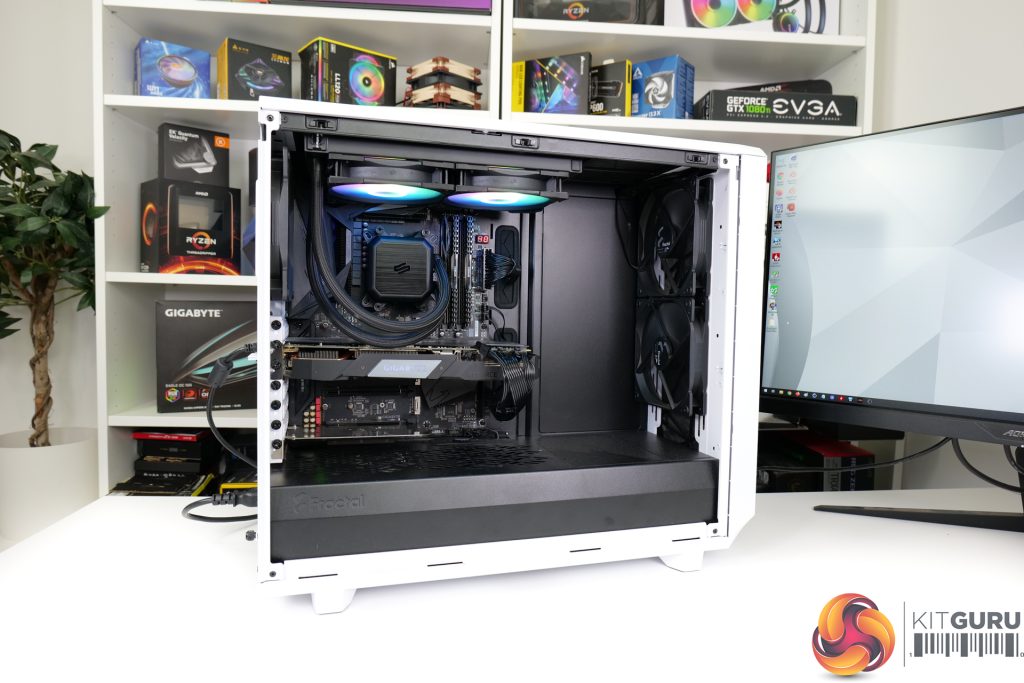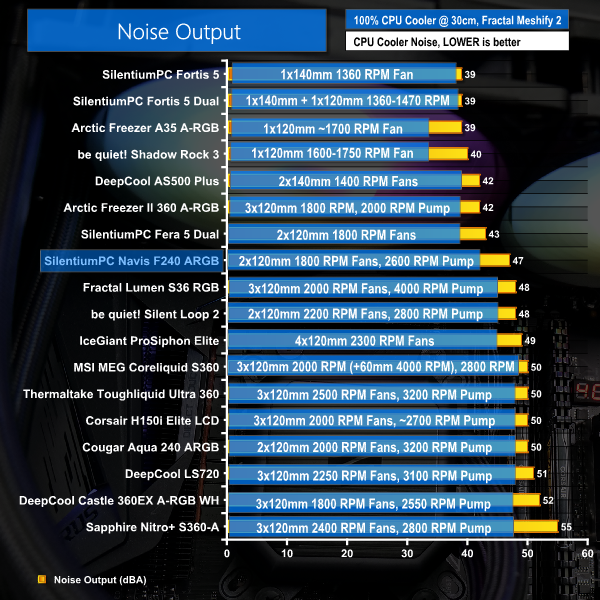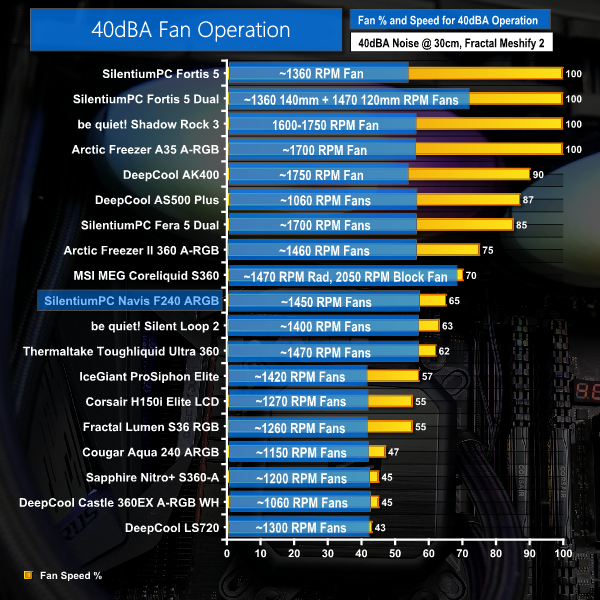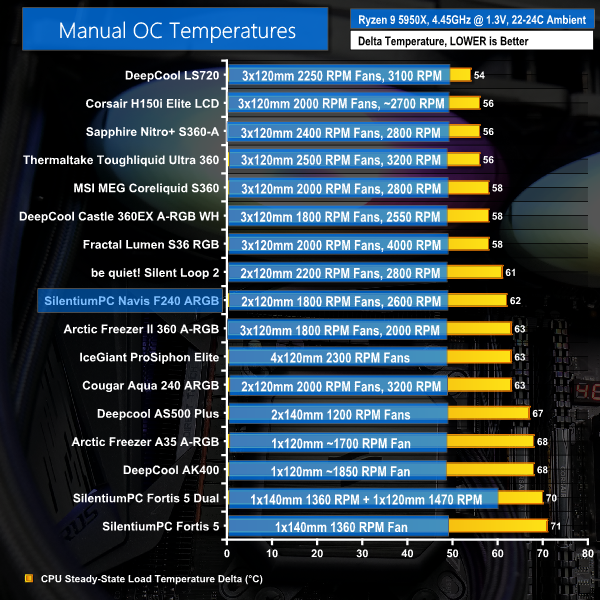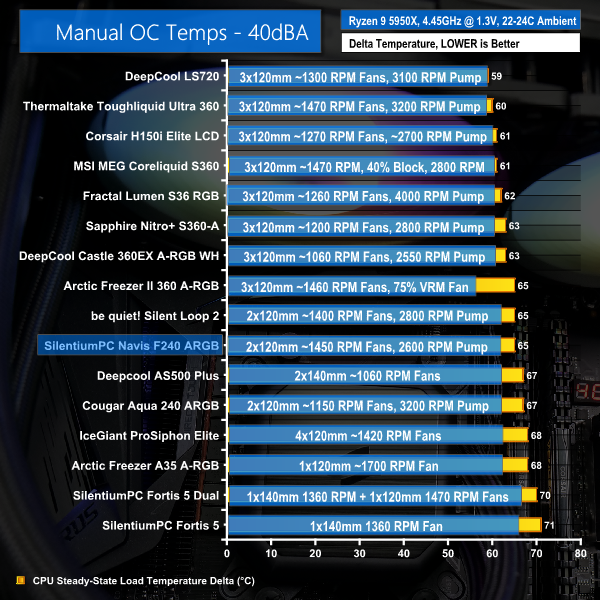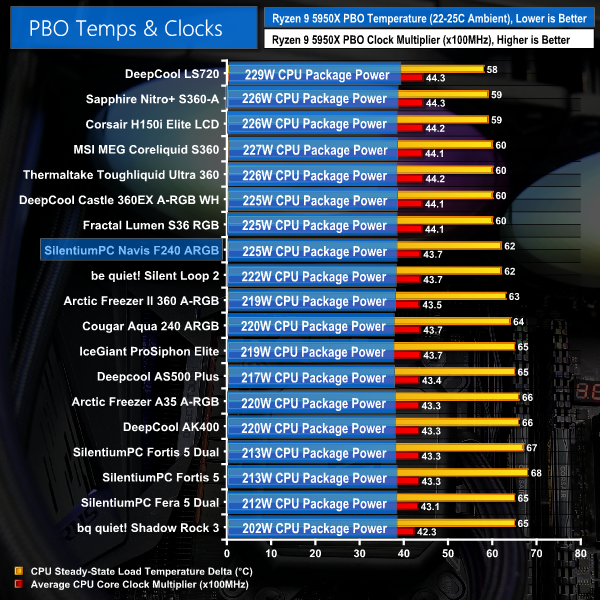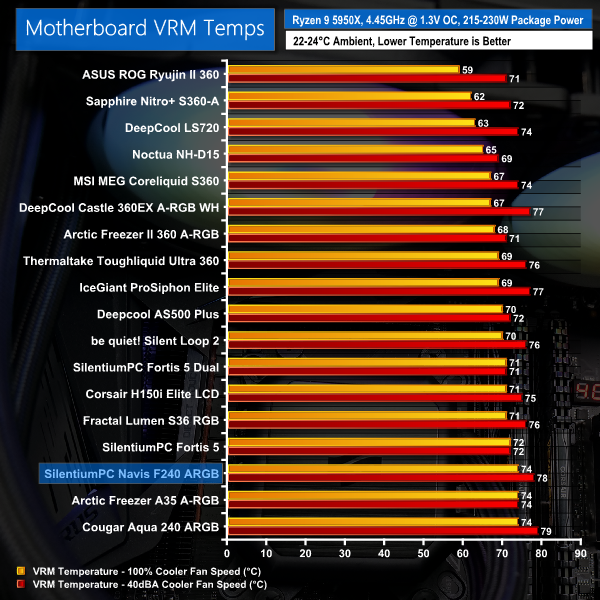Test System:
- Processor: AMD Ryzen 9 5950X
- Overclocked Settings: 4.45GHz all-core @ 1.312V (UEFI), Medium LLC – around 1.3V delivered
- Motherboard: Gigabyte B550 Aorus Master
- Memory: 32GB (2x16GB) Corsair Vengeance LPX 3600MHz 16-18-18-36 DDR4 @ 1.35V
- Graphics Card: Gigabyte RTX 2060 Super 0dB Mode
- Chassis: Fractal Design Meshify 2
- Chassis Fans: 2x140mm 1000 RPM Fractal Front Intake, 1x140mm 1000 RPM Fractal Rear Exhaust, 1x140mm 1000 RPM be quiet! Pure Wings 2 Roof Exhaust (for air cooler testing)
- Power Supply: Seasonic Prime TX-1000
- Operating System: Windows 10 Pro 64-bit
Testing Methodology:
- For testing, we use a 30-minute looped run of Cinebench R23 and record the steady-state CPU temperature at the end of the test. This ensures that the CPU has had ample time to warm up and reach steady state under all of the coolers.
- Ambient is maintained around 22-24 degrees Celsius. Where there is variation beyond this temperature range, we add in extra repeated tests to ensure consistency.
- We also test each cooler with at least two fresh installs (typically three) to mitigate the likelihood of a dodgy mount spoiling results.
Test Results:
Acoustics
Let’s start off with noise performance at 100% fan speed. This is important for getting an indication of where our performance expectations should lie based on noise output.
Running at 47 dBA in our test system, noise output from the SilentiumPC Navis F240 ARGB is reasonable when it comes to liquid coolers. The noise output is very slightly better than the be quiet! Silent Loop 2 and its 2200 RPM fans.
47 dBA at full 1800 RPM fan speeds is certainly audible, but it isn’t too unbearable for periods of heavy load. Plus, there’s the strong 300-1800 RPM PWM curve of the fans to further improve noise output.
In order to get the unit running at 40 dBA, we had to restrict the pair of fans down to 65% fan speed. This translated into around 1450 RPM operating speed according to the UEFI and HWInfo readings.
Cutting about a third off the fan speeds to hit 40 dBA noise output is actually quite reasonable. We aren’t choking the cooler too significantly in favour of noise, but we also have some capacity available if better temperatures are required.
Thermal Performance
Full-speed performance cooling an overclocked Ryzen 9 5950X processor is strong from SilentiumPC. The 240mm Navis F240 ARGB is very marginally behind the more expensive 240mm be quiet! competitor. But SilentiumPC’s cooler manages to outperform the budget-friendly Cougar Aqua 240 ARGB by a slim margin.
When locked at 40 dBA noise output, the SilentiumPC Navis F240 ARGB actually manages to very slightly improve its performance offering versus the be quiet! Silent Loop 2 240mm by matching its delta temperature. There’s clear headroom to the other 240mm AIO in our charts too – the Cougar Aqua 240 ARGB.
As always, it is critical to note that small difference in the displayed delta temperatures are not as important for our PBO testing because the clock speed and cooling power achieved are more important metrics.
With the processor running in Precision Boost Overdrive mode, once again we see solid performance from the SilentiumPC Navis F240 ARGB cooler that has it matching the 240mm be quiet! Silent Loop 2.
In fact, the Navis F240 ARGB actually manages a slightly higher power level dissipated, albeit for the same CPU clock speed, so this is a draw between those two.
Looking at the other budget 240mm AIO, Cougar’s Aqua 240 ARGB cannot keep up with the SilentiumPC offering and is once again beaten by a couple of degrees.
VRM cooling performance is uninspiring for the Navis F240 ARGB. That’s the case with the cooler running at 100% fan speed and when locked to 40 dBA fan speeds.
The Cougar Aqua 240 ARGB is just as bad as SilentiumPC’s unit when it comes to VRM cooling, but be quiet!’s Silent Loop 2 is a few degrees better in this test.
 KitGuru KitGuru.net – Tech News | Hardware News | Hardware Reviews | IOS | Mobile | Gaming | Graphics Cards
KitGuru KitGuru.net – Tech News | Hardware News | Hardware Reviews | IOS | Mobile | Gaming | Graphics Cards


